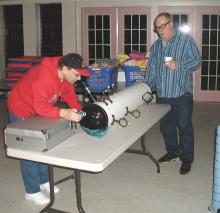Feed aggregator
Large and small galaxies may grow in ways more similar than expected
Galaxies like the Milky Way grow by merging with smaller galaxies over billions of years, unlike dwarf galaxies, which have long been thought to lack the heft to attract mass and grow in the same way. New observations challenge this view, suggesting that even dwarf galaxies can accrete mass from other small galaxies.
NASA's Pandora mission one step closer to probing alien atmospheres
Pandora, a small satellite mission poised to provide in-depth study of at least 20 known planets orbiting distant stars to determine the composition of their atmospheres cleared an important milestone by completing the spacecraft bus, which acts as the spacecraft's 'brains.'
Astronomers observe real-time formation of black hole jets for the first time
In 2018, a galaxy about 270 million light-years away from Earth exhibited a major increase in activity. It quieted down again by 2020 -- only to dramatically increase its output again in 2023. At that time, it began emitting radio waves at 60 times the previous intensity over just a few months, behavior which has never been monitored in real time for a supermassive black hole. Imaging also clearly shows a pair of oppositely directed plasma jets forming near the black hole and expanding outward over the course of 2023 -- 2024. The observation of jet formation in real time is another first. The data will help scientists understand how and under what conditions black holes produce jets.
NASA celebrates Edwin Hubble's discovery of a new universe
For humans, the most important star in the universe is our Sun. The second-most important star is nestled inside the Andromeda galaxy. Don't go looking for it -- the flickering star is 2.2 million light-years away, and is 1/100,000th the brightness of the faintest star visible to the human eye. Yet, a century ago, its discovery by Edwin Hubble opened humanity's eyes as to how large the universe really is, and revealed that our Milky Way galaxy is just one of hundreds of billions of galaxies in the universe ushered in the coming-of-age for humans as a curious species that could scientifically ponder our own creation through the message of starlight.
This quasar may have helped turn the lights on for the universe
Astronomers have detected an intensely brightening and dimming quasar that may help explain how some objects in the early universe grew at a highly accelerated rate. The discovery is the most distant object detected by the NuSTAR X-ray space telescope (which launched in 2012) and stands as one of the most highly 'variable' quasars ever identified.
Super-Earth vs. Sub-Neptune? The winner is Super-Venus!
New observational data and simulation models have confirmed a new type of planet unlike anything found in the Solar System. This provides another piece of the puzzle to understand how planets and planetary systems form.
Not all Hot Jupiters orbit solo
Hot Jupiters are giant planets initially known to orbit alone close to their star. During their migration towards their star, these planets were thought to accrete or eject any other planets present. However, this paradigm has been overturned by recent observations, and the final blow could come from a new study demonstrating the existence of a planetary system, WASP-132, with an unexpected architecture. It not only contains a Hot Jupiter but also an inner Super-Earth and an icy giant planet.
Three tiny 'stellar-ghost-town' galaxies discovered
By combining data from the DESI Legacy Imaging Surveys and the Gemini South telescope, astronomers have investigated three ultra-faint dwarf galaxies that reside in a region of space isolated from the environmental influence of larger objects. The galaxies, located in the direction of NGC 300, were found to contain only very old stars, supporting the theory that events in the early Universe cut star formation short in the smallest galaxies.
Hubble reveals surprising spiral shape of galaxy hosting young jet
The night sky has always played a crucial role in navigation, from early ocean crossings to modern GPS. Besides stars, the United States Navy uses quasars as beacons. Quasars are distant galaxies with supermassive black holes, surrounded by brilliantly hot disks of swirling gas that can blast off jets of material. Following up on the groundbreaking 2020 discovery of newborn jets in a number of quasars, aspiring naval officer Olivia Achenbach of the United States Naval Academy has used NASA's Hubble Space Telescope to reveal surprising properties of one of them, quasar J0742+2704.
NASA's Hubble tracks down a 'blue lurker' among stars
The name 'blue lurker' might sound like a villainous character from a superhero movie. But it is a rare class of star that NASA's Hubble Space Telescope explored by looking deeply into the open star cluster M67, roughly 2,800 light-years away.
New study unveils breakthrough in understanding cosmic particle accelerators
Scientists have come a step closer to understanding how collisionless shock waves -- found throughout the universe -- are able to accelerate particles to extreme speeds.
X-ray flashes from a nearby supermassive black hole accelerate mysteriously
Astronomers observed flashes of X-rays coming from a supermassive black hole at a steadily increasing clip. The source could be the core of a dead star that's teetering at the black hole's edge.









